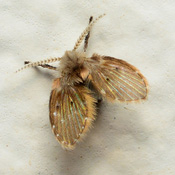Drain fly biology

Drain fly
Filter flies / Drain flies / Moth flies (Psychoda) are small flies approximately 2mm Long with a wingspan of 3mm with velvety wings. They resemble tiny moths, hence the alternative name, Moth fly.
These small flies can often be observed near wet and decaying matter (sludge, sewage etc.). The presence of these flies in large numbers is indicative of leaks, blockages or were sludge or sewage is allowed to accumulate, which is the favoured medium for breeding.
Eggs are deposited this medium and it takes about 10 – 60 days to develop into adults, which is dependent on temperature.
Larvae “swim” in this nutrient rich medium and “breathe” from the surface using a siphon.
There is currently no concrete evidence that these flies contribute significantly to disease transmission (even though the larvae usually risde in unhygienic environments) in the UK. But they can become a nuisance if large numbers accumulate in a confined space (i.e. bathrooms).
Methods to control drain flies
The removal of Drain flies depends on good housekeeping: A large number of drain-flies inside bathrooms can often be remedied by removing organic debris, like hair clogs inside drain pipe siphons, using a drain cleaner. Leaks should be remedied and sludge / stagnant water should be removed.
Non-residual ULV fumigation can be effective to remove adult drain flies. The application of insecticides on its own, however, is not sufficient as it will not address the source of the problem i.e. breeding opportunities and it is likely that drain fly problems re-occur.
